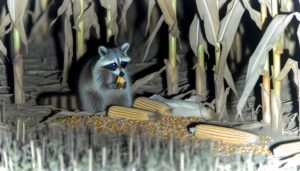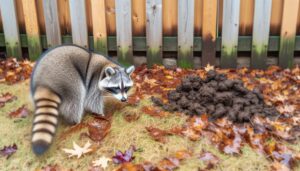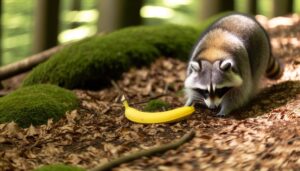Do Raccoons Eat Squirrels at Night?
Raccoons, nocturnal by nature, are known to prey on squirrels, particularly juveniles and injured individuals, during nighttime foraging. Squirrels, typically diurnal, are generally active during the day, which reduces their nighttime vulnerability.
However, raccoons' climbing skills negate squirrels' tree-dwelling safety. Their diet is diverse, including fruits, insects, and small mammals like squirrels.
Evidence from camera traps and expert insights highlight raccoons' opportunistic predatory behavior. The complex predator-prey dynamics between raccoons and squirrels in urban areas reveal the influence of human activity and environmental factors on such interactions.
For an in-depth understanding of these dynamics, consider examining more detailed studies and observations.
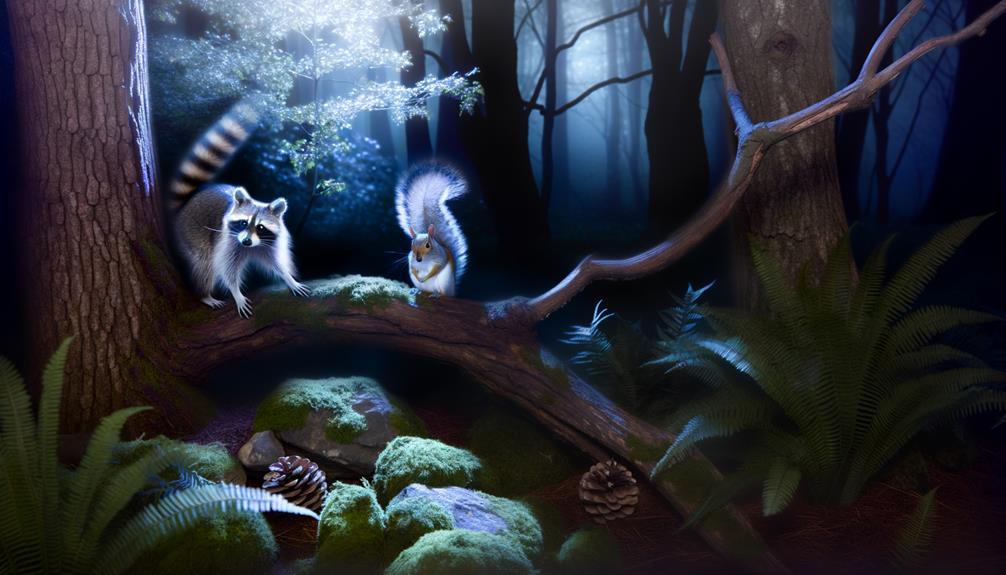
Key Takeaways
- Raccoons are nocturnal and may prey on squirrels, particularly juveniles or injured individuals, during their nighttime activities.
- Raccoons' climbing abilities allow them to access squirrels' tree nests, increasing predation opportunities.
- Camera trap footage has documented raccoons hunting squirrels, providing visual evidence of this behavior.
- Urban environments with abundant resources reduce competition but still see occasional raccoon predation on squirrels.
- Raccoons utilize their dexterity and intelligence in complex hunting strategies to capture squirrels.
Raccoon Nocturnal Behavior
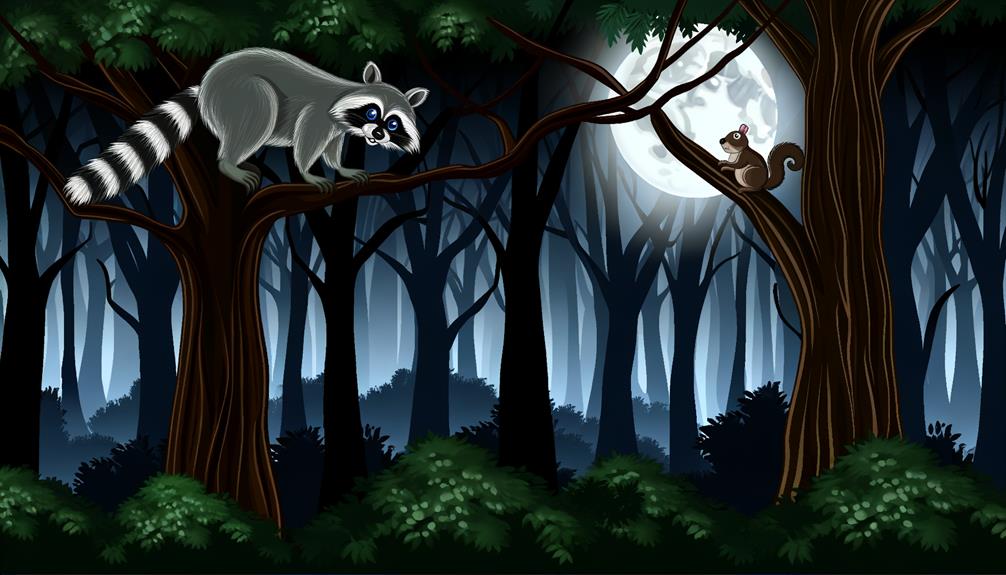
Raccoons (Procyon lotor) exhibit nocturnal behavior, primarily engaging in activities such as foraging, socializing, and territorial exploration during nighttime hours. These nocturnal habits are driven by their adaptation to reduced predation risks and competition, as well as their reliance on heightened olfactory and auditory senses in low-light conditions.
Raccoons possess highly dexterous front paws, enabling them to manipulate and access a wide range of food sources, including fruits, insects, and small vertebrates. Social interactions typically occur within family units or between neighboring raccoons, often involving scent marking to establish territorial boundaries.
Nighttime activity also facilitates the avoidance of human encounters, thereby reducing potential threats and disturbances. Understanding their nocturnal patterns is essential for comprehending raccoon ecology and behavior.
Squirrel Daily Activities
Squirrels (family Sciuridae) exhibit diurnal behavior, engaging in various activities such as foraging, nesting, and social interactions primarily during daylight hours. These rodents are known for their efficient foraging habits, collecting nuts, seeds, and fruits to sustain themselves.
Nesting activities involve constructing dreys or utilizing tree cavities for shelter and raising offspring. Social interactions among squirrels include vocalizations and physical gestures to communicate territory boundaries and mating readiness.
Their activity peaks during the early morning and late afternoon to avoid midday heat. This diurnal lifestyle aligns with their reliance on vision for locating food and monitoring for predators. Consequently, their behavioral patterns are intricately linked to daylight availability and environmental conditions, optimizing their survival and reproductive success.
Raccoon Diet Overview

As omnivorous mammals, Procyon lotor exhibit a highly adaptable diet that encompasses a diverse array of food sources, including both plant and animal matter. They consume fruits, nuts, seeds, and various vegetation, providing essential nutrients and energy.
Additionally, raccoons are opportunistic feeders, preying on insects, small mammals, birds, eggs, amphibians, and fish. Their diet also extends to readily available human-provided food sources, such as garbage and pet food. This dietary flexibility allows raccoons to thrive in diverse habitats ranging from urban areas to forests.
Their foraging behavior is influenced by seasonal availability, leading to variations in diet throughout the year. Overall, the raccoon's dietary adaptability is a key factor in its success as a species.
Squirrels as Prey
While raccoons are known for their omnivorous diet, their predation on squirrels, particularly nocturnal activity, warrants a closer examination of their interactions within shared habitats.
Squirrels, primarily diurnal rodents, exhibit behaviors and physiological traits that typically minimize their vulnerability to nocturnal predators. However, raccoons, being opportunistic feeders, may occasionally prey on squirrels, especially juveniles or injured individuals, during nighttime foraging.
The overlap in their territories, especially in urban and suburban environments, increases the likelihood of such interactions. Although squirrels' tree-dwelling habits offer some protection, raccoons' climbing abilities can negate this advantage.
Understanding these dynamics is essential for comprehending the ecological balance and predator-prey relationships within these ecosystems.
Raccoon Hunting Techniques
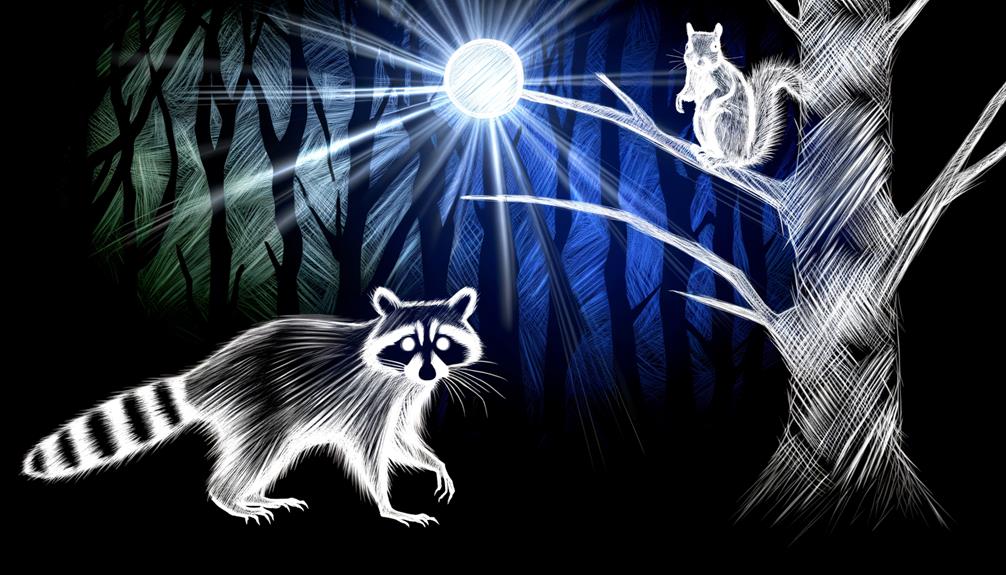
Raccoons employ a variety of hunting techniques that leverage their dexterity, intelligence, and adaptability to exploit diverse food sources effectively. These nocturnal mammals utilize their highly sensitive front paws to explore and manipulate objects, a behavior known as tactile foraging. This allows them to access hidden or hard-to-reach food items.
Raccoons are also known for their opportunistic feeding behavior, adapting their diet based on seasonal availability and habitat. They exhibit problem-solving abilities, enabling them to open containers, unseal latches, and even fish in shallow waters. Their omnivorous diet includes fruits, nuts, insects, small mammals, and birds, showcasing their flexible and resourceful nature.
These complex hunting strategies underscore the raccoon's ability to thrive in various environments.
Nighttime Encounters
Nighttime encounters between raccoons and squirrels are influenced by the distinctive nocturnal behavior of both species. Raccoons exhibit opportunistic hunting habits, which may increase the predation risk for squirrels, particularly during periods of heightened activity.
While squirrels are primarily diurnal, their occasional nocturnal forays can inadvertently expose them to predation.
Raccoon Hunting Habits
During nocturnal hours, raccoons exhibit opportunistic hunting behaviors that may include preying on smaller mammals such as squirrels. These behaviors are driven by raccoons' omnivorous diet and their adaptability in diverse environments.
Raccoons are primarily nocturnal creatures, relying on their keen sense of smell and dexterous front paws to locate and capture prey. Their hunting strategy often involves foraging through vegetation and leveraging their climbing skills to access nests or dens.
Although their diet is varied, including fruits, insects, and amphibians, the predation on squirrels is not uncommon, particularly when other food sources are scarce. This adaptability in hunting techniques underscores raccoons' ability to thrive in both urban and wild habitats, making them proficient nocturnal hunters.
Squirrel Nocturnal Behavior
Although squirrels are mainly diurnal creatures, their behavior during nighttime reveals critical survival strategies that minimize encounters with nocturnal predators such as raccoons. Squirrels exhibit several key behaviors to guarantee their safety after dusk:
- Retreat to Nests: Squirrels typically retreat to their nests or dens, which are often located high in trees, providing a secure refuge.
- Motionless Stance: To avoid detection, they remain motionless, reducing the likelihood of attracting attention through movement.
- Minimal Foraging: Nighttime foraging is rare, as it increases vulnerability to predators.
- Vigilant Awareness: Squirrels rely on acute auditory and olfactory senses to detect potential threats even while resting.
These behaviors collectively enhance their chances of surviving nocturnal periods when predators like raccoons are most active.
Predation Risk Factors
Encounters between raccoons and squirrels at night are influenced by several predation risk factors that impact the likelihood of these interactions. Primarily, raccoons are nocturnal predators, increasing the risk for squirrels that may be active or displaced from their nests.
Habitat overlap in urban and suburban areas can exacerbate these encounters, as both animals seek food and shelter in close proximity. Additionally, the availability of cover and escape routes for squirrels can greatly reduce predation risk. Vegetative density and tree canopy connectivity are essential for squirrel survival, providing means to evade raccoons.
Lastly, seasonal variations in food supply can alter the behavior of both species, potentially heightening nocturnal predation risks during periods of scarcity.
Predation Evidence
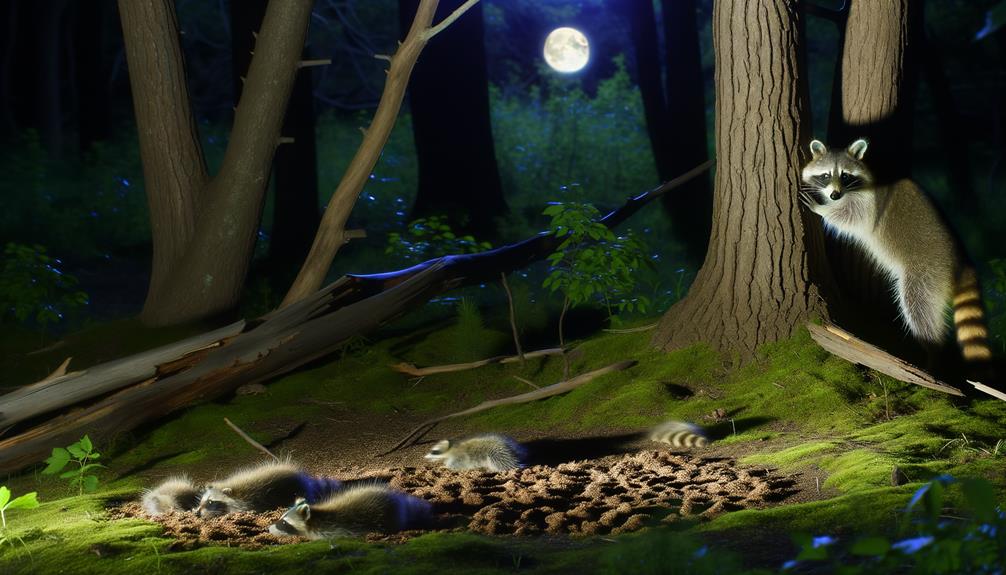
Evidence of raccoon predation on squirrels can be gathered through the analysis of tracks and scat, which can indicate the presence and dietary habits of raccoons in specific areas.
Additionally, camera trap footage provides visual confirmation of predatory behavior, capturing interactions between raccoons and squirrels during nocturnal hours.
These methods collectively furnish a thorough understanding of the frequency and context of such predation events.
Tracks and Scat Analysis
Frequently, tracks and scat left behind by predators such as raccoons provide essential evidence in understanding their dietary habits and predation patterns on nocturnal prey like squirrels. By analyzing these signs, researchers can gather valuable data regarding raccoon behavior and feeding ecology.
Key indicators include:
- Tracks: Raccoon footprints often show five toes and a distinctive heel pad; patterns can indicate stalking or ambush behavior.
- Scat Analysis: Examination of raccoon feces can reveal undigested squirrel fur, bones, and other remnants, confirming dietary inclusion.
- Location: Tracks and scat found near squirrel nests or feeding grounds suggest active predation zones.
- Temporal Patterns: The freshness of tracks and scat can indicate the timing of predation events, often aligning with nocturnal activity periods.
This scientific approach enhances our understanding of predator-prey dynamics.
Camera Trap Footage
Utilizing camera trap footage provides direct visual evidence of raccoons preying on squirrels, complementing data obtained from tracks and scat analysis. These sophisticated surveillance tools, often equipped with night vision capabilities, have captured raccoons engaging in predatory behavior under the cover of darkness.
The footage reveals critical behavioral patterns, including hunting techniques, frequency of attacks, and the specific nocturnal hours during which these events occur. This real-time visual data is invaluable, as it eliminates speculation, offering concrete proof of predation.
Additionally, camera traps help identify environmental factors, such as habitat and weather conditions, that might influence predation rates. Consequently, this method significantly enhances our understanding of raccoon-squirrel dynamics and their ecological impact.
Wildlife Expert Insights
Veterinary ecologists and wildlife biologists provide valuable insights into the nocturnal hunting behaviors of raccoons, particularly their interactions with squirrel populations. These experts emphasize that raccoons are opportunistic feeders, their diet varying based on availability and environmental factors.
Key observations include:
- Dietary Flexibility: Raccoons consume a wide range of foods, from fruits and nuts to small vertebrates, including potentially squirrels.
- Nocturnal Activity: Raccoons are primarily nocturnal, increasing interactions with tree-dwelling, diurnal squirrels during vulnerable periods.
- Predatory Behavior: Though not specialized hunters, raccoons may prey on squirrels if the opportunity arises, especially in food-scarce conditions.
- Ecological Impact: Predation by raccoons can influence local squirrel populations, although precise impacts require further study.
These insights underscore the complexity of raccoon-squirrel dynamics.
Coexistence in Urban Areas
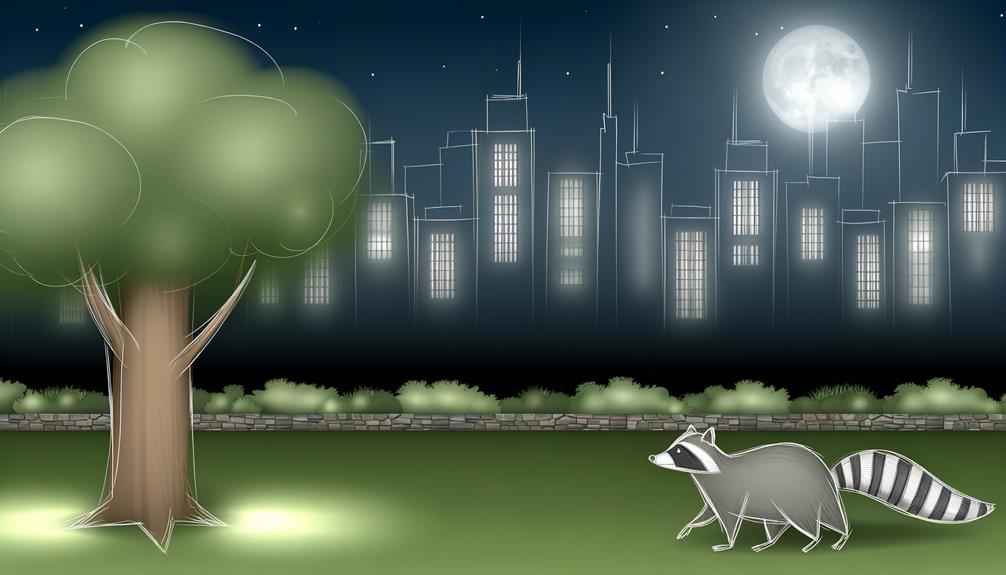
Urban environments present unique challenges and opportunities for the coexistence of raccoons and squirrels. This often leads to complex interactions influenced by human activity and resource availability. These mammals frequently share overlapping habitats like parks, gardens, and residential areas. Here, food sources such as garbage, bird feeders, and discarded human food are abundant.
The altered landscape and plentiful resources can reduce direct competition but can also heighten the potential for conflict. Raccoons, being nocturnal, tend to scavenge at night, while diurnal squirrels forage during the day, minimizing direct encounters. Nevertheless, the high density of both species in urban settings can lead to occasional predatory behavior by raccoons. However, such occurrences are generally rare and opportunistic.
Conclusion
The nocturnal behavior of raccoons and their diverse diet, which includes opportunistic predation, can lead to occasional predation on squirrels. Although raccoons primarily consume fruits, nuts, and small invertebrates, evidence indicates that squirrels can be prey, especially during nighttime encounters.
A study revealed that raccoons' predation on squirrels is relatively rare, occurring in only 2% of observed cases. Such interactions highlight the complex dynamics of urban wildlife and the adaptability of raccoons in diverse ecological niches.

